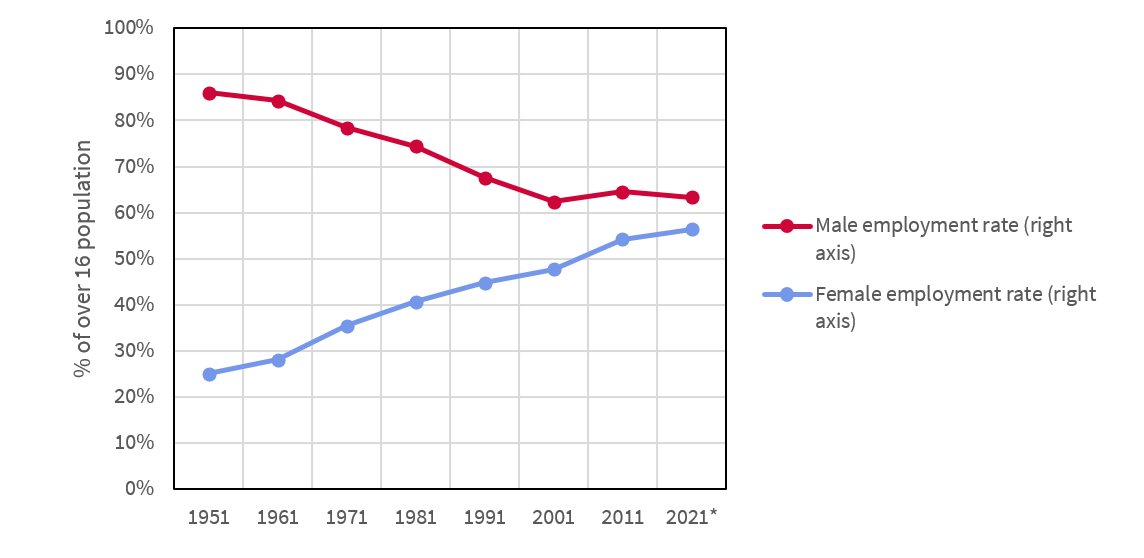Yma o Hyd? The Welsh economy of ’58
16 November 2022
On 21 November 2022, Wales will play in a World Cup finals game for the first time since our quarter final loss against Brazil on 19 June 1958. In the intervening 64 years of disappointment and near misses, from the decline of coal to the miners’ strike, and from de-industrialisation to the turn to the services sector, the Welsh economy has changed beyond recognition.
In this blog I take stock at just how much our economy has changed since the Spirit of ’58.
A “Golden Age” for the Welsh economy
After the devastation and turbulence of the Great Depression and the Second World War, the Welsh economy in the 1950s entered a period of relative stability and affluence. With low unemployment, stable prices, and rising prosperity, the period has been described as a “Golden Age” for western European economies. In 1957, Harold Macmillan famously declared that most people had “never had it so good”.
Back in ’58, Wales was a country of 2.6 million people. Amazingly, due to huge outward migration during the inter-war period, the Welsh population was still around 4% (or some 122,000) short of its 1925 peak. Out-migration would persist until the 1970s, perhaps explaining the prevalence of Welsh parents and grandparents of footballers born outside of Wales. This has only reversed in recent decades as inward migration has offset slower natural change in the population (i.e., births minus deaths).
The early post-war years saw the UK government engage in unprecedented regional economic intervention, subsidising industries and compelling them to locate in Wales. In his highly recommended book, From Depression to Devolution, Leon Gooberman described the resulting increase in employment levels as “the most ambitious, and successful, achievement of regional policy”.[1] Such interventions set Wales off on its post-war economic trajectory, and our economy was grew faster than the UK average throughout the 1950s.[2]
The 64 years since 1958 has seen a significant relative decline in Welsh economic output per person compared to UK and European averages. However, a rough estimate suggests Wales’ GDP in 2022 has grown by 254% since 1958. [3] After accounting for growth in the Welsh population, GDP per person has grown by 190% (almost tripling) since Wales’ last World Cup appearance.
Not surprisingly given everything we know about Welsh economic history, the composition of Wales’ GDP by industry has changed dramatically. The primary sectors of mining and quarrying (10%) and agriculture (5%) still accounted for a major share of Wales’ GDP in 1958,[4] compared to just 1% by 2020. The share of GDP from metal manufacturing has fallen from 12% to 2%, while all other manufacturing has fallen from 20% to 13%.
The service sector has taken its place, in particular, the share of GDP accounted for by health and education has grown from 4% in 1958 to 18% in 2020.
Consumer spending and living standards
The 1950s saw a rapid increase in consumer spending in Wales, particularly on durable consumer goods – for example, the number of cars licensed in Wales rose from 90,200 to 240,000.[5]
Comparing consumer spending then and now gives us an useful indicator of how life has changed since 1958. In a milestone study of the Welsh economy, Nevin et al. (1966) estimated that consumer expenditure per person in 1958 was £272. By 2018, this had grown to £17,568 per person – a near quadrupling after accounting for CPI inflation.
What Welsh families spend their money on has also dramatically changed. Spending on food accounted for more than a third of all consumer expenditure in 1956, and alcohol and tobacco purchases added another 14%. These shares had fallen to just 9% and 4% respectively by 2018.
Today, we spend relatively more on housing and transport, and a lot more on recreation and culture.
Figure 1: Broad comparisons of household/consumer expenditure by category, 1956 and 2018

Source: Nevin, E. (1957) The Social Accounts of the Welsh Economy, 1948 to 1956, Welsh Economic Studies No. 2, Aberystwyth: University College of Wales; Office for National Statistics (2020) Regional Household Final Consumption Expenditure
Wales last took part in a World Cup during a period of relative price stability. Inflation had dropped far below previous post-war highs and remained well-below levels that would be seen in the 1970s and 1980s. Consumer price inflation was 2.9% in 1958, compared with 10.1% in 2022.
The rise and fall of Welsh manufacturing – employment since 1958
Despite so much labour market turmoil in Welsh history, unemployment levels in 1958 (3.8%) were remarkably similar to those of today (3.7%) – although back then they were elevated compared to the standards of the time and a cause for concern.[6]
Where people worked has changed enormously. In 1958, manufacturing accounted for 22% of Welsh employment, and a further 9% were employed in metal manufacturing. Five huge industrial estates at Treforest, Bridgend, Hirwaun, Fforestfach and Wrexham were home to 60,000 workers by 1958.[7] Manufacturing employment would continue to grow for another decade before starting its long post-industrial decline to about 10% of employment today.
Figure 2: Employment by sector, Wales, 1945-2021
Source: Williams (1985) Digest of Welsh Historical Statistics, Vol.1 pp.135-9; Digest of Welsh Historical Statistics, 1974-1996, pp.139-9; ONS via NOMIS; and authors’ calculations
After a steep decline in the coal trade during the inter-war years, employment in mining continued to shrink during the 1950s, with 32 pits shutting in South Wales from 1951 and 1958. That said, 14% of Welsh employees were still employed in mining and quarrying at the time of the 1958 World Cup. This share had fallen to 5% by the time of Joe Jordan’s handball in 1977 and had all but disappeared by the time of Paul Bodin’s missed penalty in 1993.
Another trend of the 1950s which has not reversed was the rapid expansion of female employment, one of the biggest drivers of Welsh economic growth since 1958. Only 28 per cent of Welsh women aged fifteen and over were in paid employment at the time, with Wales significantly lagging the UK average in this regard.
The female employment rate has doubled between Wales’ two World Cup appearances, to 56%, as shown in Figure 3.
In contrast, despite a growing Welsh male population, there were more men in employment in Wales during the 1958 World Cup than there will be during Qatar 2022.
Figure 3: Employment rates by gender, 1951-2021
Source: Digest of Welsh Historical Statistics, Vol.1; Digest of Welsh Historical Statistics, 1974-1996; ONS via NOMIS; and authors’ calculations. Note: 2021* not a census estimate
***
Of all the striking differences between the Welsh economy in 1958 and 2022, perhaps the largest is the prospects for economic growth.
The economic backdrop for the 1958 World Cup appearance was one of (almost) full employment, sustained economic growth and rising prosperity. Qatar 2022 takes place after more than a decade-long stagnation in living standards, gloomy forecasts amidst a cost-of-living crisis, with productivity growth at its lowest rate in 250 years.[8]
For more than one reason, the Welsh economy is highly unlikely to triple in size before Wales’ next appearance at a World Cup…
***
Os hoffech ddysgu mwy am wahanol agweddau o economi Cymru, ddoe a heddiw, mae deunydd dysgu digidol ar gael o’r Coleg Cymraeg yma: https://www.porth.ac.uk/cy/collection/economi-cymru
[1] Gooberman (2017) From Depression to Devolution: Economy and Government in Wales, 1934-2006, Cardiff: University of Wales Press.
[2] Nevin, E. (1966) “The Growth of the Welsh Economy”, The Transactions of the Honourable Society of Cymrodorion 1966, pp. 134-148.
[3] This estimate combines Bank of England historic data with estimates of Wales’ GDP per person from Greary, F. and T. Stark (2016) “What happened to regional inquality in Britain in the twentieth century?’, The Economic History Review, 69(1), pp.214-228.
[4] Nevin , E., Roe, A. R. and J. I. Round (1966) The Structure of the Welsh Economy, Welsh Economic Studies No. 4, Cardiff: University of Wales Press.
[5] Thomas, B. (1962) ‘Conclusion’, IN: B. Thomas (ed.) The Welsh Economy: Studies in Expansion, Cardiff: University of Wales Press, pp. 198
[6] https://api.parliament.uk/historic-hansard/commons/1958/jul/31/unemployment-in-wales
[7] Johnes, M. (2012) Wales Since 1939, Manchester: Manchester University Press.
[8] Crafts, N. and T.C. Mills (2020) ‘Is the UK Productivity Slowdown Unprecedented?’, National Institute Economic Review, 251,47-53.
- June 2024
- December 2023
- November 2023
- August 2023
- February 2023
- December 2022
- November 2022
- September 2022
- July 2022
- April 2022
- March 2022
- January 2022
- October 2021
- July 2021
- May 2021
- March 2021
- January 2021
- November 2020
- October 2020
- August 2020
- July 2020
- June 2020
- May 2020
- April 2020
- March 2020
- October 2019
- September 2019
- June 2019
- April 2019
- March 2019
- February 2019
- December 2018
- October 2018
- July 2018
- June 2018
- April 2018
- December 2017
- October 2017
- July 2017
- June 2017
- May 2017
- April 2017
- March 2017
- February 2017
- January 2017
- December 2016
- November 2016
- October 2016
- September 2016
- Bevan and Wales
- Big Data
- Brexit
- British Politics
- Constitution
- Covid-19
- Devolution
- Elections
- EU
- Finance
- Gender
- History
- Housing
- Introduction
- Justice
- Labour Party
- Law
- Local Government
- Media
- National Assembly
- Plaid Cymru
- Prisons
- Rugby
- Theory
- Uncategorized
- Welsh Conservatives
- Welsh Election 2016
- Welsh Elections